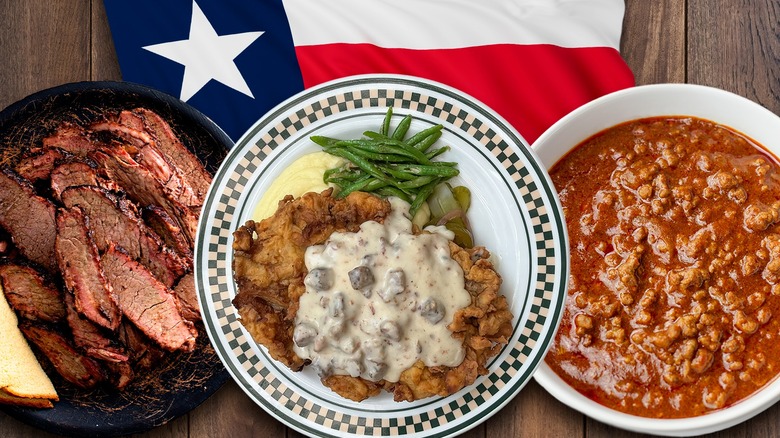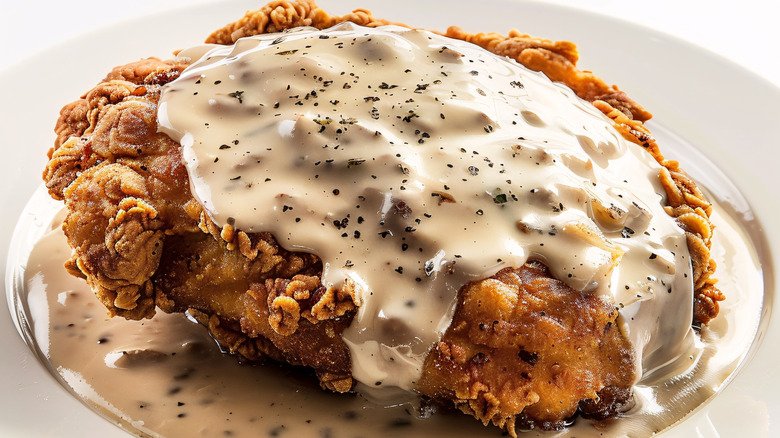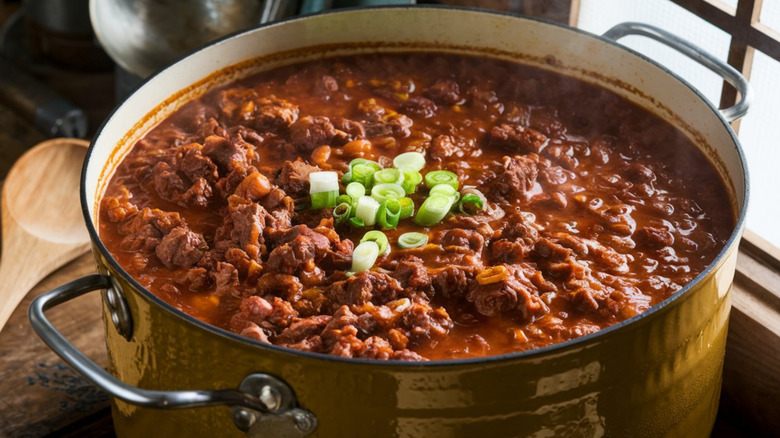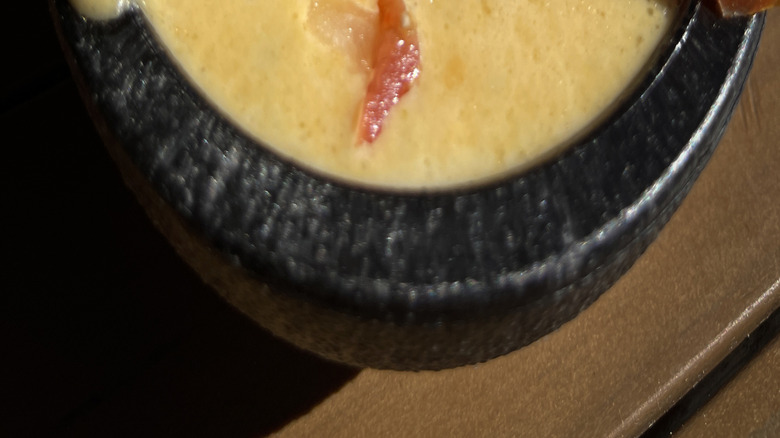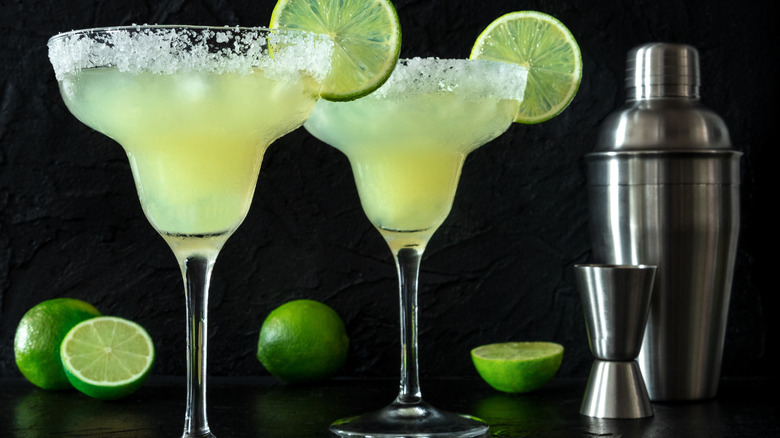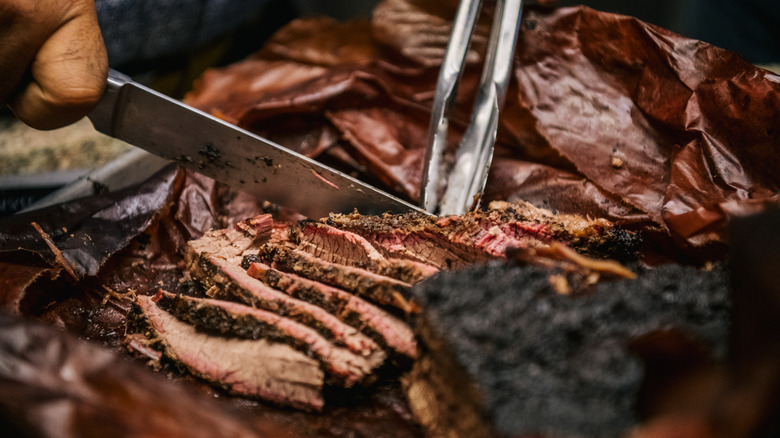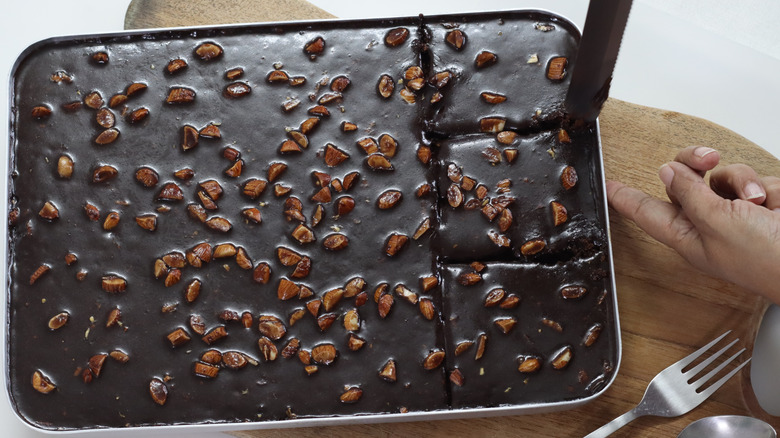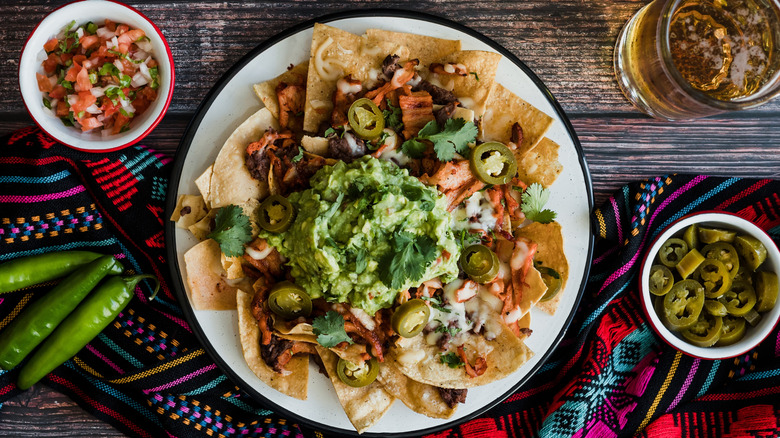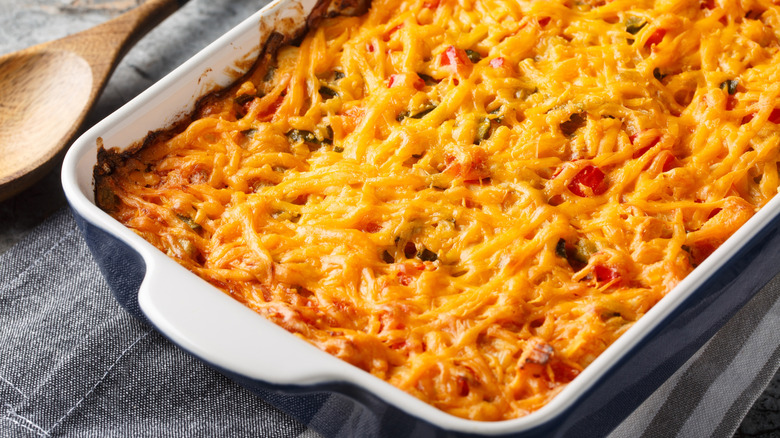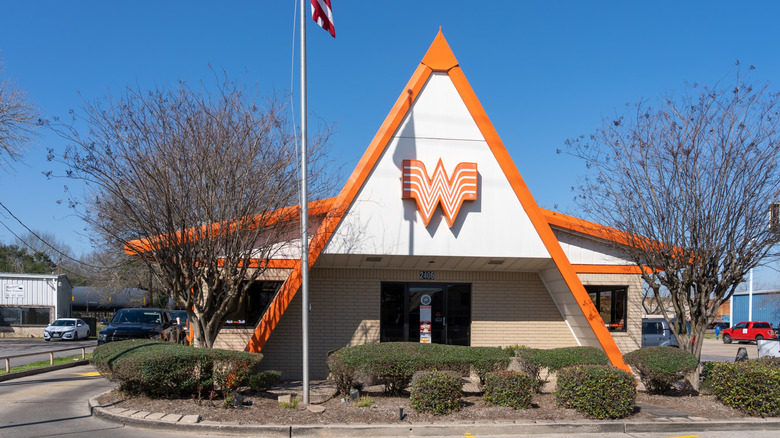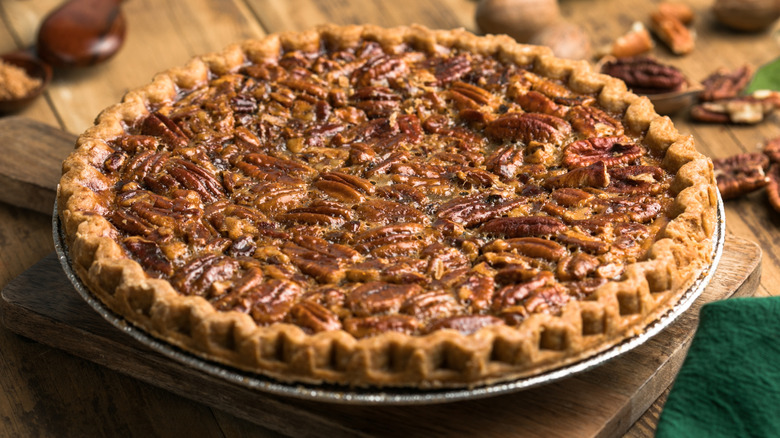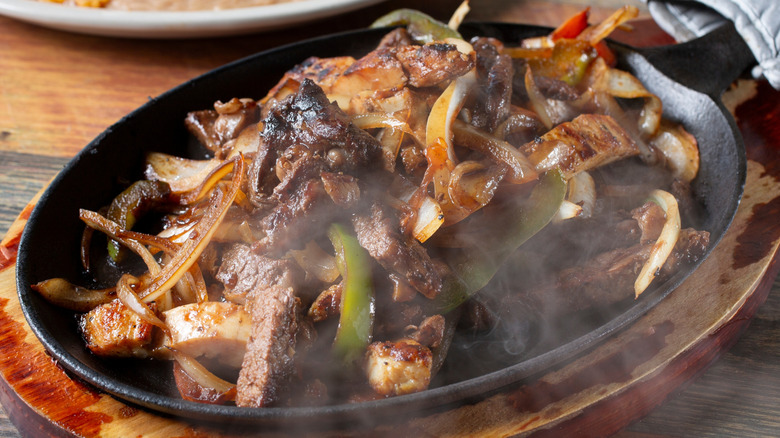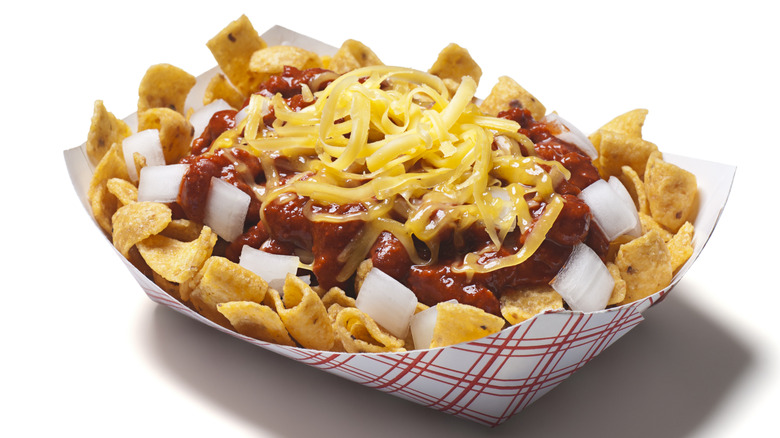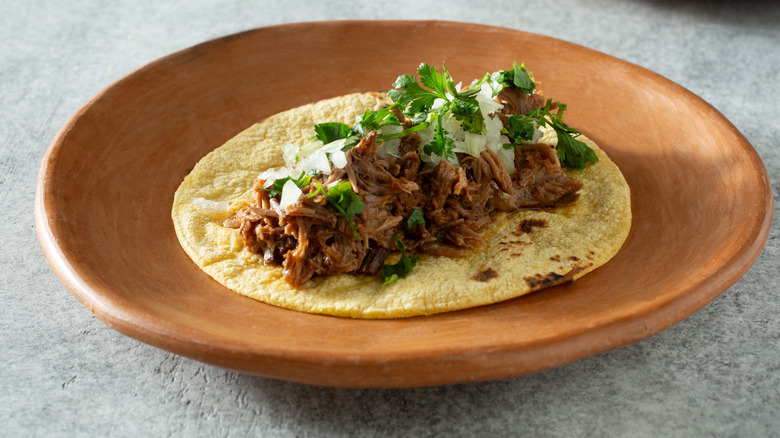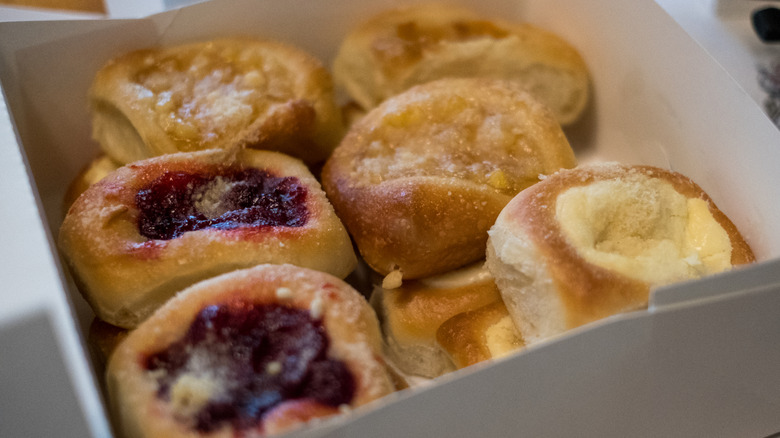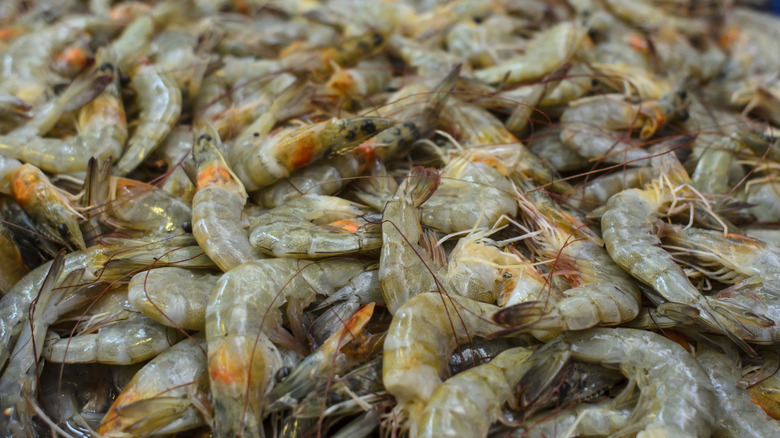Must-Try Texas Foods Everyone Should Eat At Least Once
We may receive a commission on purchases made from links.
Texas is a big state, and that is something many Texans like to brag about. They will point out that the state is larger than Germany and repeat old sayings like "everything is bigger in Texas." The vast land area includes a variety of climates and landscapes, providing ample space for agriculture like beef, vineyards, and peaches. Also, many nations have claimed the territory throughout history. Each of these occupying countries (including Spain and France) has exerted influence over the state's culture and food, diversifying and enriching the Texas cookbook. Many foods have Indigenous roots or a Creole flair, while others are even native to the Lone Star State. German and Czech immigrants added additional European touches, but, arguably, the strongest influence comes from the southern neighbor of Mexico. This interweaving of cultures, paired with the state's bold personality, comes together to create a cuisine unique to Texas. These are some of the state's must-try dishes.
Chicken-fried steak
Chicken-fried steak is a must-try dish in the Lone Star State. It's also a prime example of early Texans transforming a less-desirable cut of meat into a mouthwatering meal. The dish is traditionally made from round steak, which is naturally lean and tough. To overcome the toughness, the steak is tenderized and dredged in milk and flour before being fried. The preparation is suspiciously similar to wiener schnitzel, leading many historians to believe German immigrants are to thank for this dish.
Nowadays, while most chicken-fried steaks are deep-fried, the original method was to fry them in a skillet and use the leftover drippings to make gravy. There are numerous places to get a good chicken-fried steak in Texas, but many people choose Mary's Cafe in the small town of Strawn. Located about halfway between Dallas and Abilene, Strawn has under 600 residents, but Mary's orders some 700 pounds of steak per week to feed the crowds that flock to the restaurant. Don't worry if you can't make it to Strawn, though. Chicken-fried steak is served at restaurants and diners statewide.
Texas red chili
Chili is the state dish of Texas, and locals take it seriously. The first rule is no beans, a policy that has been strictly adhered to since the first chili cook-off at the 1952 Texas State Fair. There was a kerfuffle in 1967 when New York-based journalist H. Allen Smith dared to write an article titled "Nobody Knows More About Chili Than I Do." When the scoundrel included a recipe with pinto beans, it was more than Texas chili fanatic Wick Fowler could stomach. Fowler challenged the journalist to a cook-off in the Chihuahuan desert, which ended in a draw but started a tradition. Trying some chili at the annual competition in Terlingua –– the site of the showdown –– is a vintage Texas experience, but you can order a good bowl just about anywhere in the state. For less effort, you can recreate Wick Fowler's recipe at home with his proprietary 2-Alarm Chili Kit.
Queso
Queso is the king of Tex-Mex, and Texans can't get enough of the stuff. They slurp down bowls of it while sipping margaritas and pour even more on top of their enchiladas. The secret to a good queso starts with using the right cheese. It should be gooey without being runny and include a perfect blend of tomatoes and peppers.
One of the first restaurants to feature queso was the Original Mexican Restaurant in San Antonio. Opened in 1900, it was an early example of a Tex-Mex joint, serving Mexican-inspired fare to American crowds. The restaurant offered chile con queso on its menu, and the dip has remained a Tex-Mex staple since. Although the influential establishment closed in 1960, it was revived nearly 30 years later. The revamped Original Mexican Restaurant has been serving Tex-Mex food on the San Antonio River Walk since 1988. It's a great option for eating queso in the shadow of the Alamo, but you can find a bowl of the melted cheese statewide, so there's no excuse for skipping this Texas dish.
Margaritas
There are a few charlatans who argue that they invented the margarita, but most Texans agree the cocktail originated in 1948 at the Balinese Ballroom in Galveston. The illegal casino was popular throughout the 1930s and '40s, attracting entertainers like Frank Sinatra and Bob Hope. Conveniently located at the end of a long pier, it was protected from police raids and served as the headquarters of an organized crime family. The Texas story is that a bartender crafted the cocktail for singer Peggy Lee when she visited the ballroom. She liked it so much they dubbed it in honor of her real name, Margaret.
Regardless of the margarita's origin story, Texas' influence on the cocktail is undeniable. The first frozen margarita machine was invented at Mariano's Hacienda in Dallas in the 1970s, and Jimmy Buffett's hit song "Margaritaville" was written after sipping the cocktail at a Mexican restaurant in Austin. He even told The New York Post that he almost named it "Wasting Away Again in Austin, Texasville." If you are looking for a cocktail to accompany a plate of Tex-Mex food, the margarita is a classic choice in Texas.
Smoked brisket
When Texans say barbecue, they mean brisket. The state leads the nation in beef production and has a proud heritage of cowboys and cattle drives. Traditionally, Texans used the less desirable cuts of beef as an economical way to feed ranch hands, meaning pitmasters had to perfect the art of cooking tough meat. Brisket requires several hours in a smoker to become tender and juicy, for example.
Known as the barbecue capital of Texas, Lockhart is home to some of the state's oldest restaurants. These establishments have been selling smoked meats for about 150 years, and visiting the town's historic markets showcases the influence of German immigrants on Texan barbecue tradition. Although some of the joints smoke their meat the same way they've been doing it for years, other customs have changed. Originally, brisket wasn't served with sauce or sides like potato salad and beans. There weren't even utensils; customers would eat with their hands. Now, most Texas smokehouses offer sides and utensils, but sauce remains a contentious topic. Many traditionalists argue that a well-smoked brisket doesn't need any.
Texas sheet cake
Texas sheet cake is also known by the more somber moniker "funeral cake." The gooey dessert with chocolate frosting and crushed pecans is so comforting to Texans that it is often served to mourners following a funeral. What makes Texas sheet cake unique is that it's baked in a low-rimmed pan, giving it the thickness of a brownie.
Not only is it delicious, but Texas sheet cake is quick and easy to whip up for large gatherings. Perhaps for this reason, the brownie-like dessert is a staple at potlucks, sometimes called by the lesser-known nickname "church lady cake." Some crafty Texans have even been known to replace the pecans with crushed peppermint and serve it as a festive holiday treat. Grab a slice of sheet cake when you're in the Lone Star State for a taste of Texas hospitality.
Nachos
Nachos were invented in 1940 at the Victory Club in Piedras Negras, Mexico. The city even hosts an annual Nacho Festival to celebrate the dish. According to legend, a group of American women from the neighboring city of Eagle Pass, Texas, had crossed over into Mexico and wandered into the Victory Club for dinner and drinks. The cooks had left for the day, but manager Ignacio Anaya tossed together a quick snack using what he had on hand. The women were enthusiastic about the dish, and it became a permanent fixture on the menu. Using Ignacio's Spanish nickname, they called the plate "Nacho's Special."
The regional success got an unexpected boost from Armadillo World Headquarters, an iconic 1970s music venue in Austin. The club was one of the first major venues to serve nachos, so while the crowds came for the concerts, they also got their introduction to the Tex-Mex specialty. Nowadays, you can order nachos almost anywhere in the U.S., but you'll want to try them the traditional way in Texas.
King Ranch chicken casserole
King Ranch chicken casserole is a Southern comfort food with Texas roots. It's named for the 825,000-acre King Ranch cattle farm in South Texas. While the ranch likes to brag about being the biggest in the nation, it doesn't claim credit for the casserole. Why would a beef-producing ranch claim ownership over a chicken casserole, anyway?
While its origins are unclear, the casserole's inspiration is well known. The dish is a variation of Mexican chilaquiles and a hodgepodge of Tex-Mex flavors. The hearty dish is made with shredded chicken, layers of corn tortilla, peppers, onions, and grated cheese baked into a comforting meal. Like Texas sheet cake, the casserole makes regular appearances at potlucks and is another one of the state's popular and comforting funeral foods. The homestyle casserole is easy to make, so you don't even need to travel to sample this Texas classic.
Whataburger
While Whataburger is not technically a traditional dish, the fast food restaurant is so loved by Texans that it has to be included on the culinary tour. Launched in Corpus Christi, Whataburger has expanded to several other states, but the majority of its locations are in Texas. Given the state's affinity for the fast food chain, Texan lawmakers officially declared it a state treasure in 2001.
Whataburger was founded in 1950 on two core principles. The first was to let customers customize their burgers, and the second was to serve something hefty enough to make people exclaim, "What a burger!" when lifting it. Most Texans find it to be a satisfying burger made with 100% beef and topped with fresh vegetables. It's also a popular breakfast spot that serves biscuit sandwiches, pancakes, and taquitos. With more than 750 Whataburgers in Texas, you're likely always near a location when you're in the Lone Star State.
Pecan pie
Pecans have a special place in Texans' hearts, and many insist on the proper pronunciation of "puh-KAHN." If you mispronounce it, they may pretend not to understand and force you to shout "PEE-can" until people stare judgmentally and shake their heads. It's similar to the reaction New Yorkers have when they hear a Texan pronounce Houston Street for the first time.
Pecan became the official state pie as a result of a 2013 first-grade class project. The students of Georgetown's Ford Elementary School determined that since the pecan tree and nut were state symbols, it was only fitting that the pie receive a similar designation. They traveled to Austin and lobbied lawmakers with slices of pie. The resolution passed, so when you're in Texas, find a bakery or restaurant where you can enjoy a slice of the state pie.
Fajitas
Sizzling beef fajitas on a hot iron skillet are a show-stopping dish at Tex-Mex restaurants. While they're trendy now, fajitas were once a humble dish made by vaqueros (Mexican cowboys) working on ranches in Texas. Vaqueros were given the cheapest cuts of beef, including skirt steak, to cook for their meals. The cowboys developed methods for cooking these meats that became a foundation of Tex-Mex cuisine. Skirt steak was often marinated in lime juice, for example, then grilled over mesquite coals.
Sonny Falcon and Ninfa Rodriguez Laurenzo are two Texans who can take a lot of credit for popularizing fajitas. Falcon traveled the state with the first commercial fajita concession stand starting in 1969, while Laurenzo operated a popular chain of restaurants in Houston. Fajitas weren't invented in Houston, but it was the first city to fall in love with them. The original Ninfa's opened in 1973 and is an excellent choice for fajitas, but you can now find the sizzling dish on nearly every Tex-Mex menu.
Peach cobbler
The Texas Legislature has a certain fixation on recognizing the state's official sweet treats. In addition to pecan pie, they passed resolutions honoring sopaipilla, strudel, and peach cobbler. Particularly loved by Texans, cobbler is a popular dessert that has been around since the time of British colonists in America. It's made with fresh fruit, topped with a crumble, and, as the Texas Legislature specified, it's perfect with a scoop of vanilla ice cream.
The Texas Hill Country is renowned for fresh peaches, and Gillespie County, just west of Austin, has roughly 600 acres of orchards. While Texas produces a large amount of peaches, very few are exported. One of a Texan's favorite ways to get peaches is by visiting the roadside stands and markets. Buckets of fresh fruit are available, and customers rave about the sweet flavor. "There is little comparison between fresh peaches and the metro grocery store peaches," one customer told Texas Highways. The best time to enjoy peach cobbler in the Lone Star State is during the summer months at the peak of the season.
Texas tannat
In addition to peaches, Texans know the Hill Country as the epicenter of the Texas wine industry. In recent years, the number of wineries has increased to about 450, with most of them scattered throughout the countryside around Fredericksburg. Texas produces many varietals of wine, but tannat is emerging as a local favorite. The intense red wine has a dark, nearly purple, color and is rich with tannin.
Texas wineries have increasingly started producing high-quality wines. They won 295 awards at the most recent San Francisco Chronicle Wine Competition, trailing only California. However, Texas wines have yet to gain national attention, with most being sold within the state. An informed visitor knows to visit Hill Country wineries, but a well-informed one knows to sample the varietals that grow well in the Texas climate. Tannat is vying for position as a signature grape in Texas, and you can find a nice glass at many wineries. The bold red is something every oenophile should try, preferably in a rocking chair with a view of the Texas Hill Country.
Frito pie
Despite having plenty of elbow room, Texas still has to deal with its pesky neighbors. One example is New Mexico's insistence that it invented the Frito pie, although Texas also asserts ownership. Ask a Texan, and they'll tell you the dish combines chili, cheddar cheese, and salty corn chips or Fritos. They'll also tell you that New Mexico's fabrication is easily debunked. Frito-Lay apparently served the pie at a Dallas convention in 1949, more than 10 years before New Mexico claims to have invented it. Either way, the dish came to the nation's attention in 1962 when Frito-Lay printed the recipe on the bag and introduced America to the snack. Although Frito pie is more widespread now, wherever you enjoy it, take a minute to reflect on the contentious origin story of this national treasure.
Barbacoa
Barbacoa is a traditional method of slow-cooking meat that traces its history to Indigenous Mexican practices. The meat is sealed into a brick-lined pit with hot coals and is usually left to roast overnight. In northern Mexico and Texas, barbacoa refers almost exclusively to beef. This can even include the cow's head, which was one of the discarded pieces of meat given to vaqueros for food. When slow-roasted in pits, the beef becomes exceptionally tender, resulting in a flavor similar to pot roast or shredded brisket.
Vera's Backyard Bar-B-Que in Brownsville is probably the last place to get barbacoa cooked the traditional way. Although health regulations banned in-ground cooking in the late '70s, Vera's was granted an exception. The cherished Texas barbecue joint only serves cow head barbacoa and was awarded the coveted James Beard Award in 2020. If you can't make it to Brownsville, barbacoa is available in many other locations where it is often made in steamers or slow cookers.
Kolaches
Fresh-baked kolaches are one of Texans' favorite comfort foods, the perfect snack for long road trips across the big state. Czech immigrants came to Texas throughout the second half of the 19th century, bringing their heritage and new customs to the state. One of these novelties included traditional sweet buns called kolaches. These pastries were small mounds of dough wrapped around a piece of fruit. While the customary fruit and cheese kolaches are plentiful in Texas, sausage kolaches are also popular. A purely Texan creation, the sausage kolache was invented at the Village Bakery in a town called West, Texas. After opening in 1952, this Czech American bakery was also the first to sell kolaches commercially. You can still buy the baked good at the Village Bakery, but there are several other options as well. Two popular alternatives are about 14 miles apart in southeastern Texas, including Weikel's Bakery in La Grange and Hruska's Bakery in Ellinger.
Wild Texas brown shrimp
You might not guess it, but Texas has thousands of miles of coast along bays, inlets, and the Gulf. This gives the state plenty of access to the ocean's bounty. In coastal Texas, fresh seafood is a common part of the diet. Of all the commercial fishing done in the Lone Star State, shrimp is the primary catch. Together with Louisiana and Alaska, Texas is one of the country's top shrimp producers.
Most of what is caught by Texan shrimpers is brown shrimp, which have a strong, marine-forward flavor that pairs well with spicy foods like étouffée and gumbo. Although Cajun food is most closely associated with Louisiana, you'll find similar culinary influences in East Texas. France is one of the six nations that have claimed jurisdiction over Texas throughout history, meaning many of the state's foods have a French twist. Whether eaten in gumbo, étouffée, fried, or boiled, Texas wild brown shrimp is a seafood you need to try.
